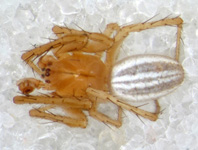Abstract
The aim of this note is to clarify some aspects posed by Araya et al. (2016) in the description of the columbellid gastropod Astyris atacamensis for northern Chile, and also to complement it for providing further insight on important ecological aspects of the genus Astyris in the SE Pacific. Araya et al. (2016) fill an important gap, describing a species that in my opinion is important in many aspects, yet, they fail in connecting this new species with previous work in which this taxon has been mentioned. Araya et al. (2016) indicate that the genus has not been previously reported for the SE Pacific; however, Levin et al. (2002a) already mention finding Astyris permodesta (Dall, 1890) off Callao, Perú (~12°S). Astyris permodesta, originally described for the coast of California, is currently accepted under the genus Alia (Monsecour 2015). Although we still cannot confirm, most probably future analysis will prove that A. permodesta reported for Perú by Levin et al. (2002a) corresponds indeed to the new species Astyris atacamensis. Future work should elucidate the definitive placement of this species in either Alia or Astyris, but hereafter I will indistinctly use Astyris.
References
Araya, J.F., Catalán & R. & Aliaga, J.A. (2016) A new deep-water Astyris species (Buccinoidea: Columbellidae) from the southeastern Pacific. Zootaxa, 4139 (1), 140–144.
https://doi.org/10.11646/zootaxa.4139.1.11Bernhard, J. & Reimers, C. (1991) Benthic foraminiferal population fluctuations related to anoxia: Santa Barbara Basin. Biogeochemistry, 15, 127–149.
https://doi.org/10.1007/BF00003221Fuenzalida, R., Schneider, W., Garcés, J., Bravo, L. & Lange, C. (2009) Vertical and horizontal extension of the oxygen minimum zone in the eastern South Pacific Ocean. Deep-Sea Research II, 56 (16), 992–1003.
https://doi.org/10.1016/j.dsr2.2008.11.001Levin, L. (2003) Oxygen minimum zone benthos: adaptations and community responses to hypoxia. Oceanography and Marine Biology: an Annual Review, 41, 1–45.
Levin, L.A., Gutiérrez, D., Rathburn, A.E., Neira, C., Sellanes, J., Muñoz, P., Gallardo, V.A. & Salamanca, M.A. (2002a) Benthic processes on the Peru margin: A transect across the oxygen minimum zone during the 1997–98 El Niño. Progress in Oceanography, 53, 1–27.
https://doi.org/10.1016/S0079-6611(02)00022-8Levin, L.A. & Michener, R.H. (2002b) Isotopic evidence for chemosynthesis-based nutrition of macrobenthos: The lightness of being at Pacific methane seeps. Limnology and Oceanography, 47 (5), 1336–1345.
https://doi.org/10.4319/lo.2002.47.5.1336Milessi, A.C., Sellanes, J., Gallardo, V.A. & Lange, C.B. (2005) Osseous skeletal material and fish scales in marine sediments under the oxygen minimum zone off northern and central Chile. Estuarine, Coastal and Shelf Science, 64, 185–190.
https://doi.org/10.1016/j.ecss.2005.02.013Monsecour, K. (2015) Alia permodesta (Dall, 1890). In: MolluscaBase (2015), accessed through: World Register of Marine Species. Available from: http://www.marinespecies.org/aphia.php/aphia.php?p=taxdetails&id=511706 (accessed 21 October 2016)
Mosch, T., Sommer, S., Dengler, M., Noffke, A., Bohlen, L., Pfannkuche, O., Liebetrau, V. & Wallmann, K.J.G. (2012) Factors influencing the distribution of epibenthic megafauna across the Peruvian oxygen minimum zone. Deep-Sea Research I, 68, 123–135.
https://doi.org/10.1016/j.dsr.2012.04.014Quiroga, E., Sellanes, J., Gerdes, D., Arntz, W., Gallardo, V.A. & Hebbeln, D. (2009) Demersal fish and benthic megafaunal assemblages of the continental margin off Chile: influence of the oxygen minimum zone on the bathymetric distribution. Deep-Sea Research II, 56, 1061–1072.
https://doi.org/10.1016/j.dsr2.2008.09.010Sellanes, J., Quiroga, E., Neira, C. & Teixido, N. (2010) Diversity patterns along and across the Chilean margin: a continental slope encompassing oxygen gradients and methane seep benthic habitats. Marine Ecology, 31, 111–124.
https://doi.org/10.1111/j.1439-0485.2009.00332.xThiel, M., Macaya, E.C, Acuña, E., Arntz, W.E., Bastias, H., Brokordt, K., Camus, P.A., Castilla, J.C., Castro, L.R., Cortés, M., Dumont, C.P., Escribano, R., Fernández, M., Gajardo, J.A, Gaymer, C.F., Gómez, I., González, A.E., González, H.E., Haye, P.A., Illanes, J.E, Iriarte, J.L., Lancellotti, D.A., Luna-Jorquera, G., Luxoro, C., Manríquez, P.H., Marín, V., Muñoz, P., Navarrete, S.A., Pérez, E., Poulin, E., Sellanes, J., Sepúlveda, H.H., Stotz, W., Tala, F., Thomas, A., Vargas, C.A., Vásquez, J.A. & Vega, A. (2007) The Humboldt Current System of Northern-Central Chile: Oceanographic processes, ecological interactions and socioeconomic feedback. Oceanography and Marine Biology an Annual Review, 45, 195–345.

